The dual theme of my A to Z Challenge this year is the world of Commodities and Poetry Forms so the juxtaposition of these two themes may throw up some strange poems – could be a Heroic Ode to Heating Oil or will it merit a Haiku or a Haibun – whichever, I will be endeavouring to bring you interesting facts about commodities that may change the way you think about the stuff we variously depend on…
By commodity I mean certain items that are of both sufficient value/volume to be traded in special markets and are generally volatile enough to attract traders in “Futures” which are a way of hedging bets in the trading world of stocks, shares and commodities.
The A to Z Challenge runs throughout April and will consist of 26 posts – there are only a couple of letters for which I couldn’t find commodities but plenty of poetry forms to carry the day!
In 2022, Wool was the world’s 663rd most traded product, with a total trade of $3.28B.
Once again, I couldn’t find a Commodity beginning with “Y” so I am going with another “W” one – one I previously had a difficulty in choosing Wheat over – but I did find a Poem form beginning with “Y” so poetry saves the day again…
I live just North of the Leeds Bradford conurbation and those two towns owe a lot to wool – in fact at one time, Bradford had more millionaires than any other city in England! Not to say that every mill was weaving wool – some wove cotton and some mills swapped between the two textiles. Although the industry declined from the 19th Century onwards due to competition from overseas mills using cheap labour – there are still some factories in Bradford which are part of the wool industry. Wool was an important industry in Britain since at least the 13th Century and there are still 31.8 million sheep in the UK today although many of them are raised for meat with wool being a byproduct. So with signs of the wool industry all around me I am glad to have the opportunity to write about it.
In Roman times – European clothing was made from wool, leather and linen with cotton from far-off India a mere curiosity and Silk from China a rare and expensive luxury. By the 15th Century, the value of wool trading to England was reflected in the fact that the presiding officer of the House of Lords sat on a Woolsack and since 1275 , a tax on wool called the “Great Custom” had been financing king and country. As the demand for wool rose, acts of enclosure, official and unofficial, stole common land from the common people – a right to which they had been entitled to since Edward the Confessor. Although compensation, financial or in the form of lesser quality land was sometimes forthcoming, it represented nothing like the increase in value of the land to the landowners. In Scotland, whole swathes of the Highlands were cleared of people in favour of sheep who were, after all, low-maintenance agricultural creatures who converted poor grazing into wool and meat…

writes Michael Green in The Guardian. Photograph: Owen Humphreys/PA
The bare hills of the highlands are the result of sheep grazing to this day, and preventing the establishment of native trees with which the hills were once clad. The dispossession of people resulted in emigration to the New World and left Britain short of labour and with a reduced military capability all of which caused inflation in the economy. At one time, the government attempted to restrict enclosure for just these reasons. Other effects of the wool trade was the eradication of wolves and the improvement of transport infrastructure – first roads and later, in the 19th century – canals and railways. The Leeds-Liverpool Canal runs from Leeds, skirts Bradford and passes through my village on its way to the port of Liverpool thus enabling coal in and goods out from this industrial heartland – or as Blake described it “dark Satanic mills…” Arguably, wool is the single most important element responsible for shaping many aspects of the English landscape.
In the 19th century, towns were transformed as much as the countryside had been with the advent of the Industrial Revolution and here in my village of Silsden alone, there were two substantial mills. These mills were powered by the new steam engines and one consequence of these steam engines that people today have forgotten about, was the ash… When we first arrived here in Silsden, a stretch of buried culvert was being uncovered as it was in danger of collapsing. One very upset man told me how he had bought his old (farm) house without knowing that he was responsible for the maintenance of this buried culvert. The small valley had been blocked in a triangular section 60 feet across and 20 feet deep, by the town rubbish dump, but in the main – this rubbish consisted of the ash from the mills – that is a lot of ash! It cost the man £60,000 to dig up his garden to a depth of 20 feet in order to have his section of culvert repaired!!! So when I look at all the mills around Yorkshire – I wonder where each of their ash heaps were… The coal to feed the steam engines might have come from Leeds originally but when that area was exhausted, then it came in to villages like mine, from Liverpool by canal.
Between here and Leeds is Salts Mill and the surrounding World Hertiage site of Saltaire Village built by one of the most successful of those 19th Century Bradford millionaires. It is one of the largest mills of its kind and when built, contained the largest room in the world! When it closed in the 1970’s, it was seen s an enormous white elephant until a man with vision bought it comparatively cheaply and repurposed it as what we now understand to be an industrial estate. Jonathan Silver, was also a friend of David Hockney whose work now has a permanent home in the 1843 Gallery which takes its name from the date when the mill was constructed.
Looking briefly at the three main wool companied still working in Bradford – British Wool is the intermediary between farmers and the wool trade – I pass their modern warehouse on my way to work and if the doors are open, all you can see are hundreds of identical bales of wool…
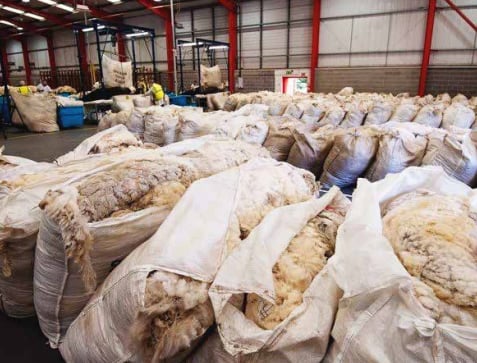
Haworth Scouring is just down the hill from where I work and they do the job of cleaning and combing wool – a job which was done as a cottage industry before the industrial revolution and though you nevere see much from the outside other than the odd lorry coming and going, in 2017, they made a A multi-million GBP investment in state of the art Schlumberger Era combing machinery which has the capacity to produce up to 150,000kgs wool tops per week and to comb wools from 22µm – 40µm. All that happens after the cleaning (scouring) part where the wool is washed of wool grease (lanolin), dirt and other vegetable material.

Lastly – just a few miles downt the valley from where I live, is Atkinson Dyeing who complete the final stage of bulk wool production – the dyeing. I love that all these elements of wool production are still up and running and all around me…
And so to the aspect of Wool as a Commodity – as the box below shows – Australia is the largest producer of wool and so the world market in wool is pegged to the $Australian which is quite unusual I think.
🇦🇺🇨🇳🇳🇿 Australian, Chinese & New Zealand Production. Australia is the biggest producer of wool, accounting for roughly 23.4%. China and New Zealand produces 15.5% and 9.1% respectively. These three countries produce almost half of the world’s wool, so any supply disruptions in these countries could have an impact on prices.
Information from Medium
Global Demand (Especially China & The US). Although wool is considered to be a high-value, niche product, it’s a globally traded commodity. The US is the largest importer of woollen textiles and apparel, and China is a major consumer of woollen products.
If you have been following this series on Commodities, you will probably know by now that anything involving trade between the US and China is liable to be subject to a tarrif war and you are not wrong “the US increased import tariffs on Chinese woollen apparel by 15%. This pretty much decreased demand on the US side.” (Medium)
We have not looked at what wool is used for these days – clothing is still the big one but furnishing fabrics, carpets and the surprise newcomer – Ecofriendly Building Insulation. Furthermore, there is the Lanolin byproduct obtained from scouring the wool which is used in “personal care, cosmetic, and baby products, and is also used in pharmaceutical and industrial industries. According to various market research firms, the global lanolin market size itself was about USD 290 million in 2019.” (Medium).
And so to today’s poem which is a Ya-Du:
The Ya-Du is a Burmese form of poetry which consists of up to three stanzas of five lines. The first four lines of a stanza have four syllables each, but the fifth line can have 5, 7, 9 , or 11 syllables.
The form uses a climbing rhyme. The rhyme is required on the fourth, third, and second syllables of both the first three lines and the last three lines.
e.g.:—A–A–A-B–B–B—
What I found difficult with this form, was not the climbing rhyme but simply writing with a mere four syllables per line…
Wool
Knitted in time
for her fine son
the kind mother
is rather proud
of her knit and son…
Teen with Mum clashes
knits old fashioned
no cash for new
so knit you love
love through and through
When old Mum dies
then son flies home
scent lies in vest
to nose pressed now
and rest of life…

© Andrew Wilson, 2024
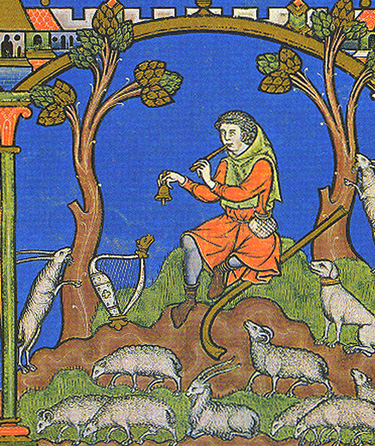
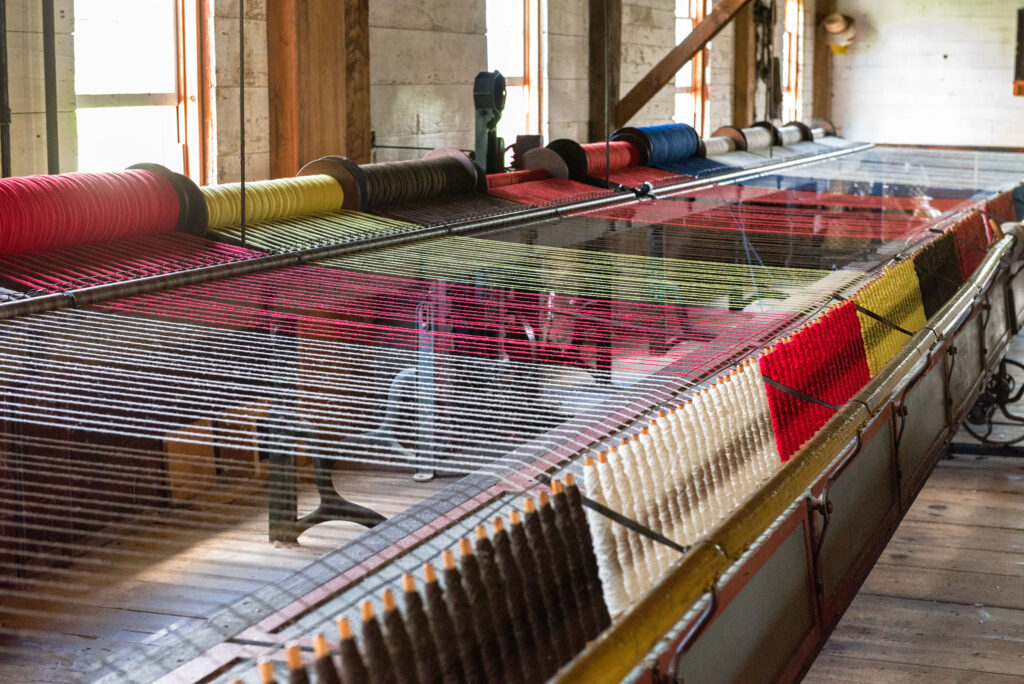


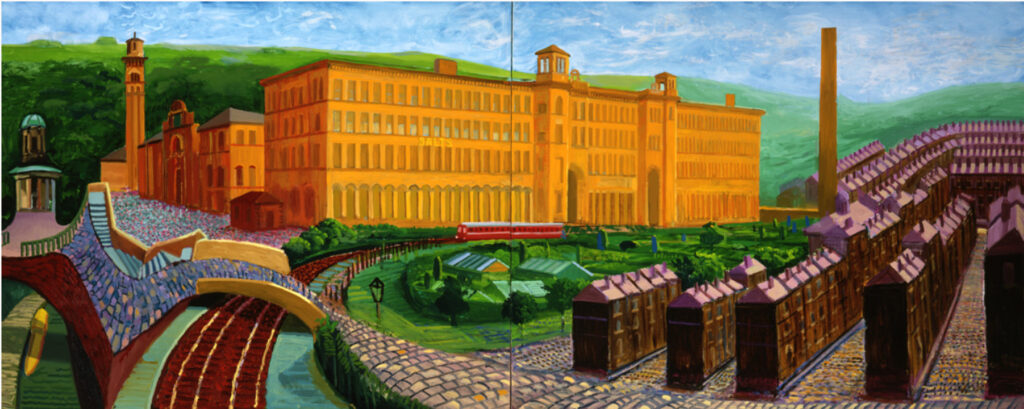
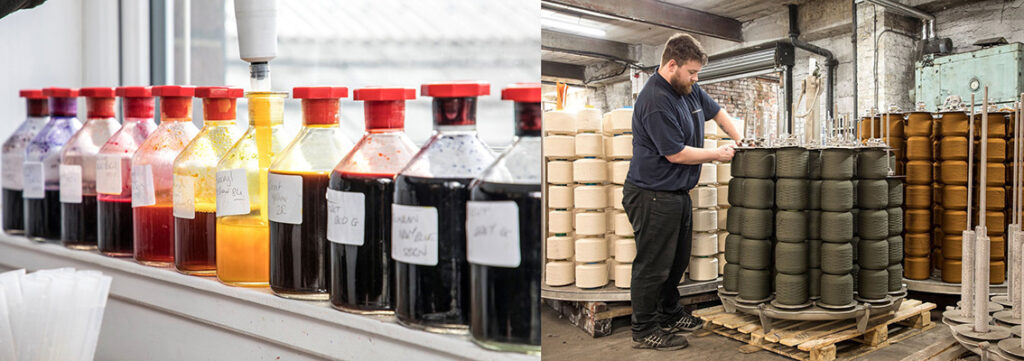
Never imagined the wool industry has such an impact on the British and Scottish landscape. It’s kind of scary.
That Salts Mill is impressive!
Yes in so many ways sheep have changed things…
I thought this was very interesting, thank you.
Locksley from George’s guinea pig world
Thanks Locksley…
The history of the world was kind of defined by the production of wool. A bit, anyway. Very interesting info.
Thanks Liz – I would love to go round those factories and tell the whole story…
I never really realized everything that revolved around the production of wool.
Indeed – historically for Britain but as the legacy industry of Bradford shows – still of some significance – thanks for visiting Kristin…
This one was really interesting to me. I have converted to almost all wool along with cotton/flannel and linen items, thanks to participating in a 100 day dress challenge (the reward was $100 gift certificate towards another dress). That was started in December 2022 and I finished in March 2023. Since then, I have purged my wardrobe of a ton of things I didn’t wear or didn’t fit, and replaced it with wool. I still have some synthetics (colorful print leggings being one), but most is gone. Thanks for a great post!
Lucky you are not allergic to wool, neither am I but my mother and sister are. I love cotton except for the creasing. I am sure I could slim my wardrobe down a lot if I was ruthless about what i don’t wear but I am a keeper – for example I have a shirt that I chose in part payment for a signwriting job when I lived in Ireland – it is frail now but I can’t get rid of it…